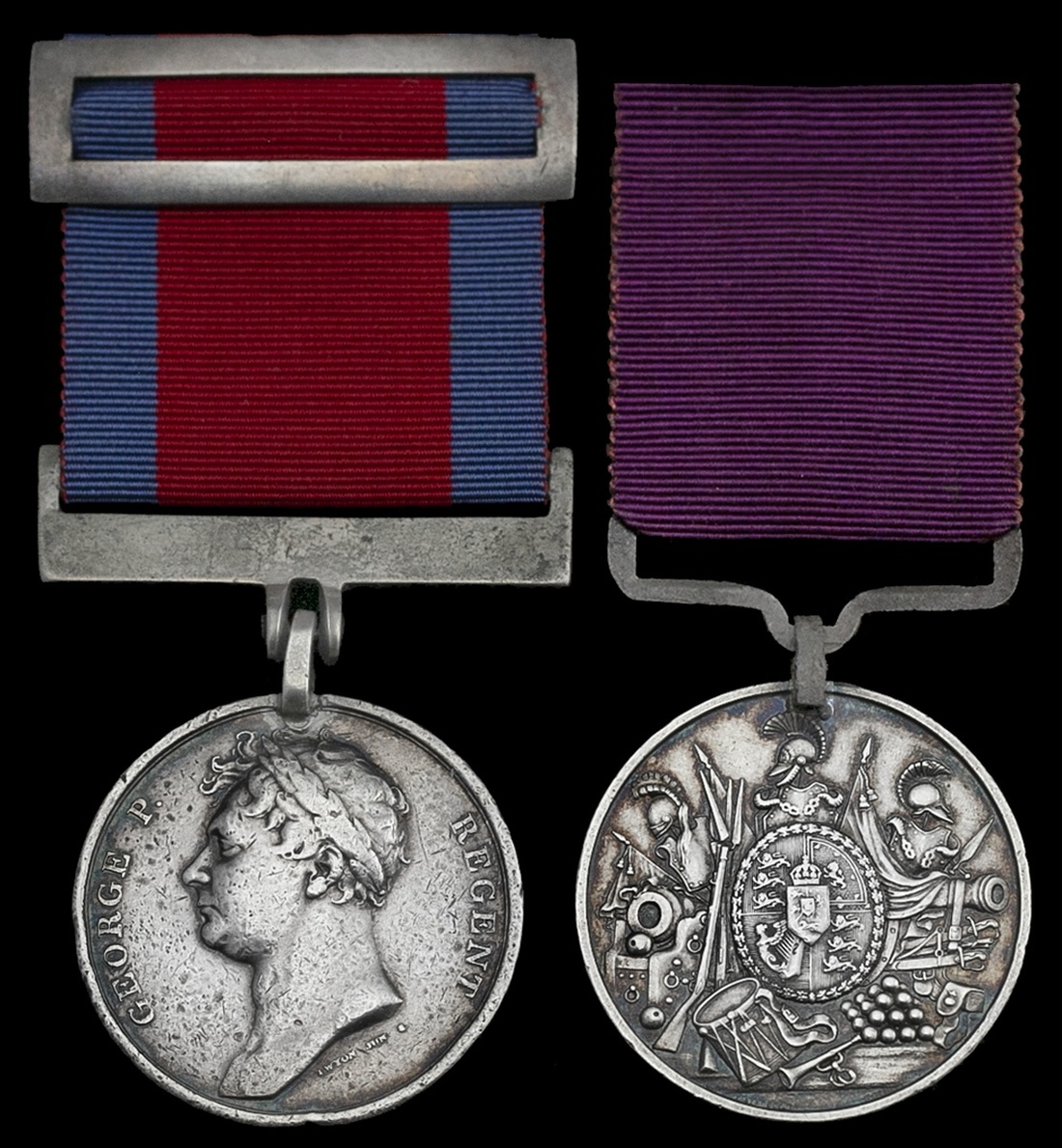Auction: 19001 - Orders, Decorations and Medals
Lot: 590
Pair: Colour-Sergeant A. Matthews, Coldstream Guards, a defender of Hougoumont
Waterloo 1815 (Corp. Andrew Matthews, 2nd Batt. Coldstream Gds.), fitted with contemporary silver bar suspension and ribbon buckle; Army L.S. & G.C., W.IV.R. (A. Matthews, Color Serjt. Coldstream Guards. 1834), fitted with original steel clip and rectangular bar suspension, the first well-worn and pitted, fine, the second good very fine (2)
Provenance:
Ex-Sir Torquil Mattheson Collection.
Andrew Matthews was born in the Parish of Warkworth, Northumberland. Employed as a weaver, he served in the local militia until 8 December 1813, when he enlisted at Haddington for unlimited service in the 2nd Battalion, Coldstream Guards. He was then aged 23. Promoted Corporal on 4 February 1814, his discharge papers reveal that he served in France and the Netherlands for four years and four months. He may have been present at the Siege of Bergen op Zoom on 8 March 1814, when a composite Guards Brigade under Lord Proby launched an unsuccessful assault on the fortifications of the Dutch town, 25 miles north of Antwerp. The French garrison put up fierce resistance, the local populace against expectations remaining loyal to Bonaparte. Lord Proby's attack was an unmitigated disaster, resulting in the death or capture of two-thirds of the Guards Brigade.
Matthews served in the 1815 Waterloo Campaign as a Corporal with Lieutenant-Colonel The Hon. H. R. Pakenham's Company, 2nd Battalion, Coldstream Guards. The Battalion formed part of Major-General Sir John Byng's 2nd Guards Brigade, and was ordered to recapture Bossu Wood from Jérôme's Division at the Battle of Quatre Bras on 16 June. French voltigeurs (skirmishers), wearing dark blue and green, picked off the scarlet British guardsmen as they struggled through the undergrowth and scrub. When eventually the Guards emerged from the wood and reformed into line, they were forced back by Piré's 6th Lancers and 1st Chasseurs. A costly stalemate, Quatre Bras at least bought Wellington time to extract his forces and re-deploy on the ridge of Mont St. Jean, just nine miles south of Brussels, Napoleon's objective.
At the Battle of Waterloo on Sunday 18 June, the 2nd Guards Brigade were deployed on the reverse slope, to the extreme right of Wellington's line. To their front was the vast farmhouse complex of Hougoumont, a name forever associated with the Coldstream Guards. From 11.30 a.m. to about 8.30 p.m., the strongpoint was attacked continuously by Rielle's Corps. Initially it was held by the 2nd Nassau Regiment, with Light Companies from each Guards Battalion in support. When the famous 'Closing of the Gates' episode occurred at 1.30 p.m. there were barely 200 British soldiers inside, while their German co-defenders numbered 1,000. At 2 p.m., following the repulse of D'Erlon's Corps, the remainder of 2nd Battalion, Coldstream Guards (including Matthews) were ordered down from the ridge. Matthews and his comrades then stood on the firesteps and aimed through the loopholes of Hougoumont's red-brick walls, coolly throwing back every French assault for the next six hours.
The Coldstream Guards were stationed in Paris as part of Wellington's Army of Occupation until 1817. Remaining with the 2nd Battalion, Matthews was promoted to Sergeant on 29 September 1819 and Colour-Sergeant on 1 January 1829. He was discharged on 11 February 1834, aged 43, his papers describing him as 'totally unfit'. His character was nevertheless reported to be: 'that of a good & efficient soldier, seldom in Hospital, trustworthy and sober.' Granted a pension of 'One Shilling and Ten Pence per diem', he was recommended for the award of the Long Service & Good Conduct Medal which he received the following year; sold with copied discharge papers.
Subject to 20% VAT on Buyer’s Premium. For more information please view Terms and Conditions for Buyers.
Sold for
£2,200







